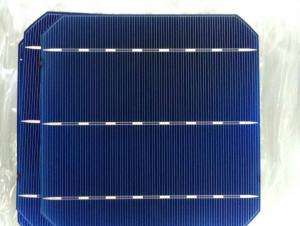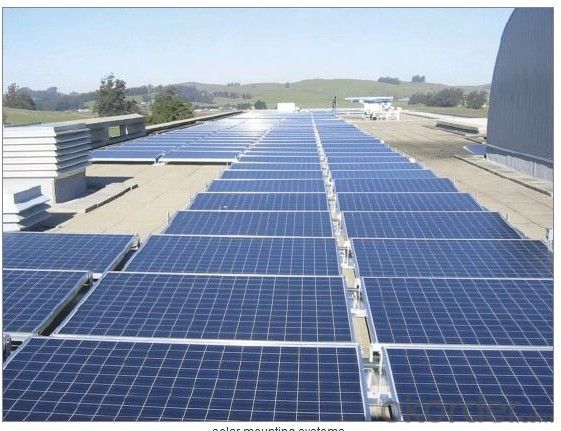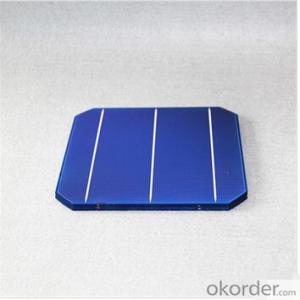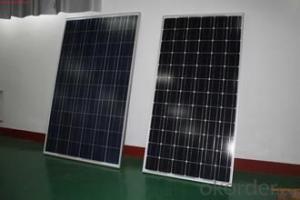Laser Scribing Monocrystalline Silicon Solar Cells
- Loading Port:
- China Main Port
- Payment Terms:
- TT or LC
- Min Order Qty:
- -
- Supply Capability:
- -
OKorder Service Pledge
OKorder Financial Service
You Might Also Like
Quick Details
| Model Number: | monocrystalline solar cell 156x156 | ||||
| Material: | Monocrystalline Silicon | Size: | 156x156mm | Number of Cells: | 1 |
| Max. Power: | 4.6 | Color: | Blue | Main Bus bar: | 3BB |
| Grade: | B-Grade | Thickness: | 180/200 ± 20μm | Voltage: | 0.508V-0.53V |
| Efficiency: | 19.26% | Product: | In stock | Trade term: | Exw Shenzhen |
Packaging & Delivery
| Packaging Detail: | Neutral package |
| Delivery Detail: | 8-15 working days |
Specifications
1) Buy solar cells
2) mono solar cells
3) monocrystalline silicon solar cell price
4) Manufacturer Price

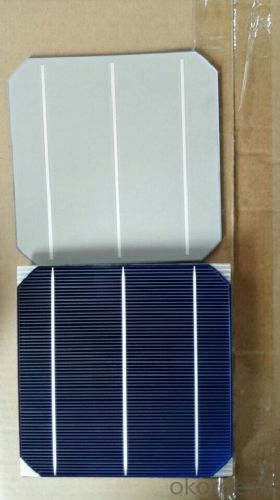
Most solar modules are currently produced from crystalline silicon (c-Si) solar cells made of multicrystalline and monocrystalline silicon. In 2013, crystalline silicon accounted for more than 90 percent of worldwide PV production, while the rest of the overall market is made up of thin-film technologies using cadmium telluride, CIGS and amorphous silicon Emerging, third generation solar technologies use advanced thin-film cells. They produce a relatively high-efficiency conversion for the low cost compared to other solar technologies. Also, high-cost, high-efficiency, and close-packed rectangular multi-junction (MJ) cells are preferably used in solar panels on spacecraft, as they offer the highest ratio of generated power per kilogram lifted into space. MJ-cells are compound semiconductors and made of gallium arsenide (GaAs) and other semiconductor materials. Another emerging PV technology using MJ-cells is concentrator photovoltaics (CPV).
- Q: How does the efficiency of solar cells vary with different materials?
- The efficiency of solar cells varies with different materials due to their varying properties and characteristics. Some materials, like silicon, have high efficiency as they have a suitable bandgap for absorbing sunlight and converting it into electricity. Other materials, such as thin-film materials like cadmium telluride or perovskites, may have lower efficiency but offer advantages like flexibility or lower production costs. Overall, the efficiency of solar cells is highly dependent on the specific material used and its ability to convert sunlight into electrical energy effectively.
- Q: How to define the poly solar cells as the A Grade one?
- If the poly solar cells is high module conversion efficiency, through superior manufacturing technology Guaranteed -1% to +3%, it is very possibily the A grade.
- Q: Can solar cells be used in camping or outdoor recreational activities?
- Yes, solar cells can be used in camping or outdoor recreational activities. They are portable and can be easily carried while camping, hiking, or engaging in other outdoor activities. Solar cells can charge various devices such as phones, cameras, and portable speakers, ensuring that you have power even in remote locations where traditional electricity sources may not be available.
- Q: How do solar cells handle bird droppings or other debris?
- Solar cells are generally designed to be self-cleaning or have a protective coating that prevents bird droppings or debris from significantly impacting their performance. Rainwater or regular cleaning can often wash away most of the dirt or droppings, ensuring optimal solar energy generation.
- Q: Can solar cells be used for powering remote sensors?
- Yes, solar cells can be used for powering remote sensors. Solar cells convert sunlight into electricity, making them a reliable and sustainable source of power for remote applications. They are commonly used to provide continuous power to sensors in remote locations, where access to the electrical grid may be limited or non-existent.
- Q: How do solar cells handle hail or other physical damage?
- Solar cells are designed to be durable and withstand various weather conditions, including hail or physical damage. The cells are typically made of tempered glass, which is highly resistant to impact. Additionally, solar panels are tested and certified to meet certain industry standards for hail resistance. In the event of severe damage, such as a shattered panel, individual cells can be replaced without affecting the overall performance of the solar system.
- Q: Can solar cells be used in countries with limited sunlight?
- Yes, solar cells can still be used in countries with limited sunlight. While solar cells generate the most electricity under direct sunlight, they can still generate power even in cloudy or overcast conditions. Additionally, advancements in solar panel technology have made them more efficient in capturing diffuse sunlight, enabling their use in regions with limited sunlight.
- Q: How much do solar cells cost?
- The cost of solar cells can vary depending on various factors such as the type and size of the system, installation requirements, location, and quality of the panels. On average, residential solar panel systems can range from $10,000 to $30,000 or more. However, it is important to consider long-term savings on electricity bills and potential government incentives that can offset the initial investment.
- Q: How do solar cells perform in regions with high levels of snowfall and blizzards?
- Solar cells generally do not perform optimally in regions with high levels of snowfall and blizzards. The snow accumulation on the solar panels can significantly reduce their ability to generate electricity as it blocks the sunlight from reaching the cells. However, advancements in technology and design have led to the development of snow-resistant solar panels that can shed snow more easily and continue to generate electricity even in snowy conditions. Additionally, the angle and tilt of the panels can also play a role in snow shedding. Overall, while solar cells may not perform at their highest efficiency in regions with heavy snow, it is still possible to generate some electricity with proper installation and maintenance practices.
- Q: Where can I get the most accurate information about solar cells?
- The library is always the best place to go.
Send your message to us
Laser Scribing Monocrystalline Silicon Solar Cells
- Loading Port:
- China Main Port
- Payment Terms:
- TT or LC
- Min Order Qty:
- -
- Supply Capability:
- -
OKorder Service Pledge
OKorder Financial Service
Similar products
Hot products
Hot Searches
Related keywords

